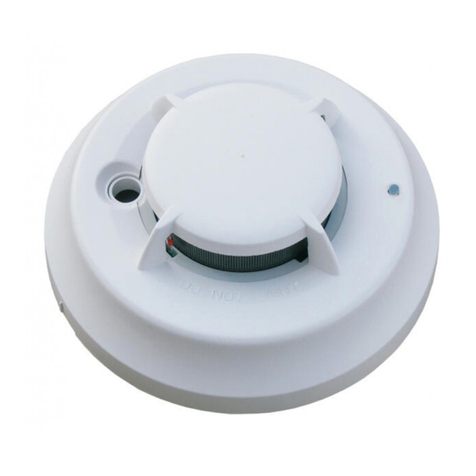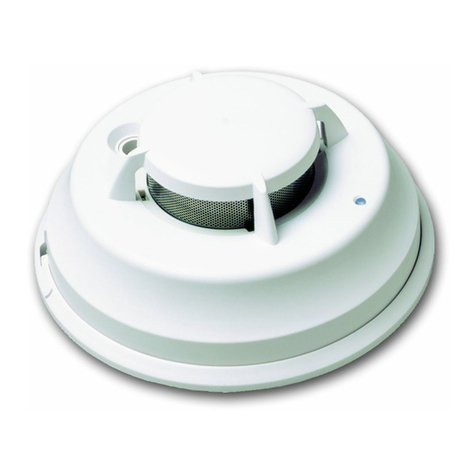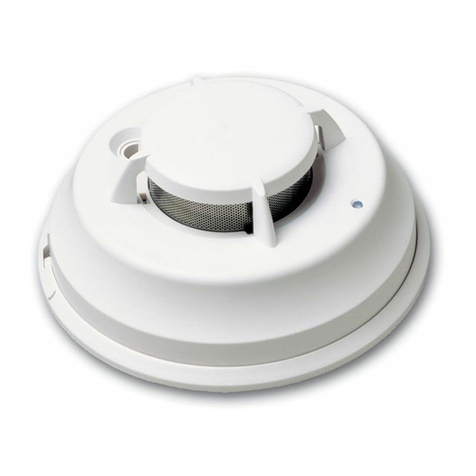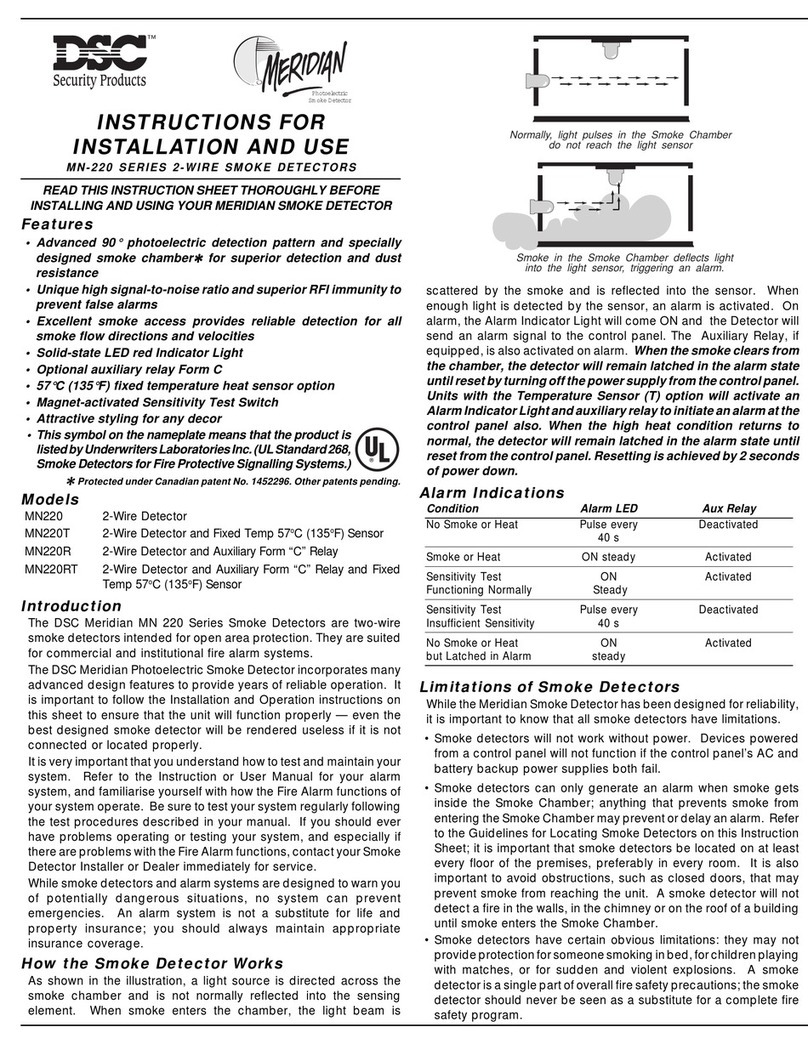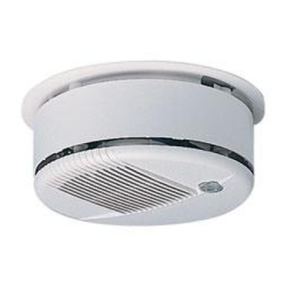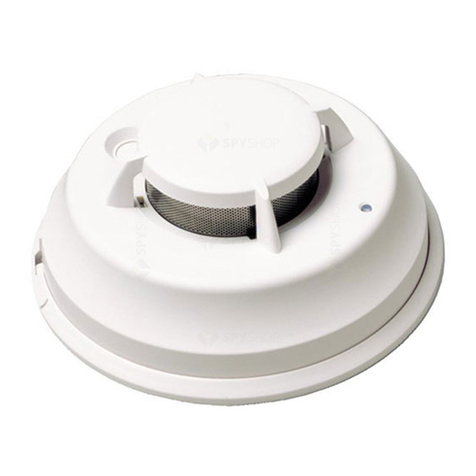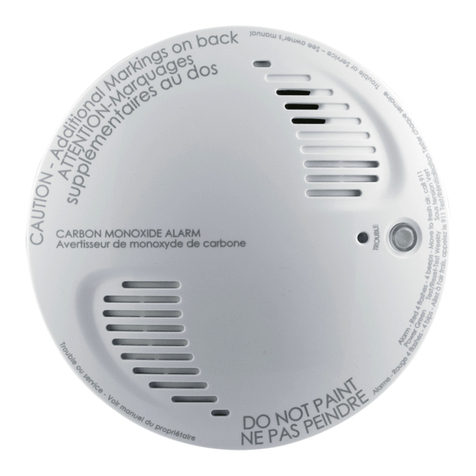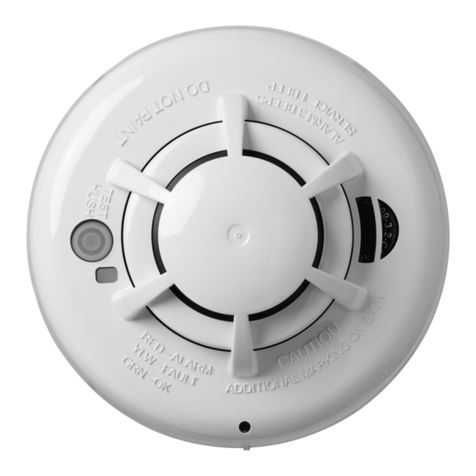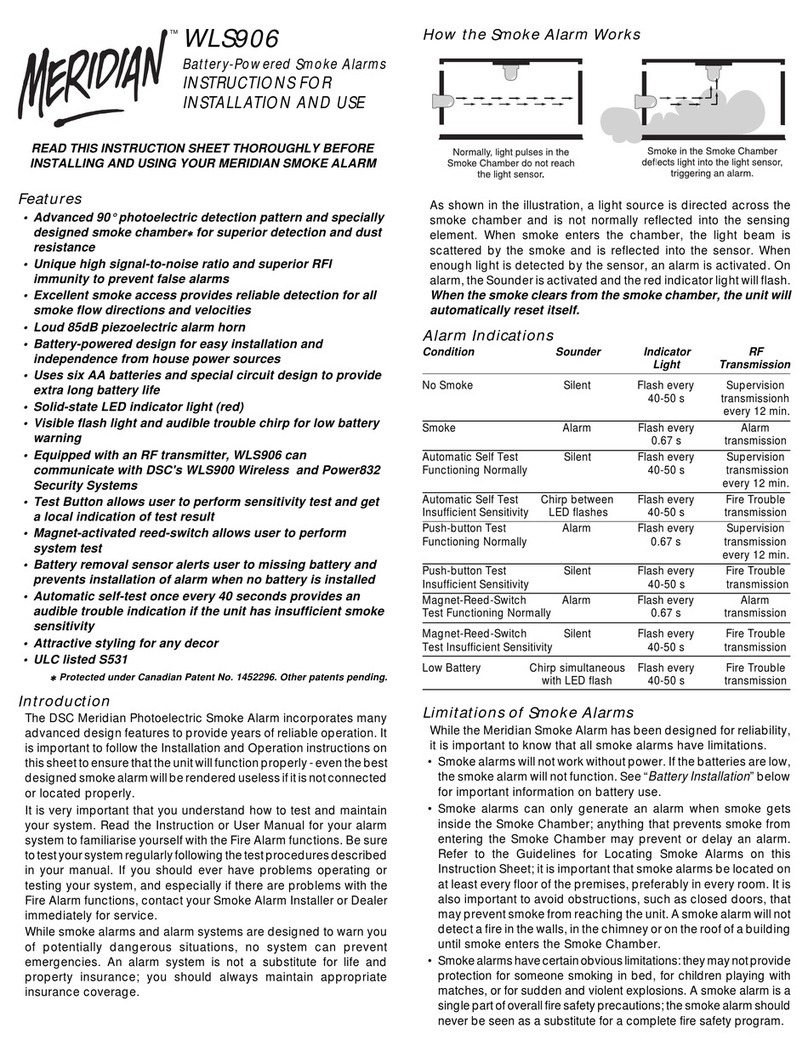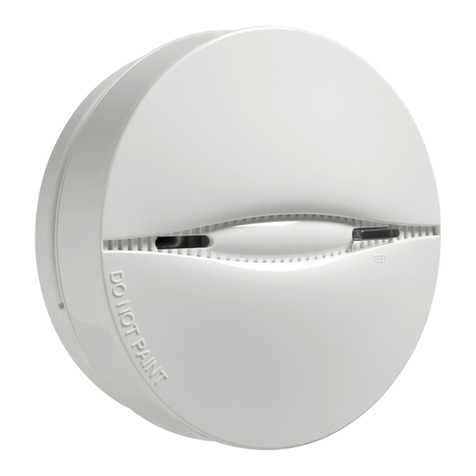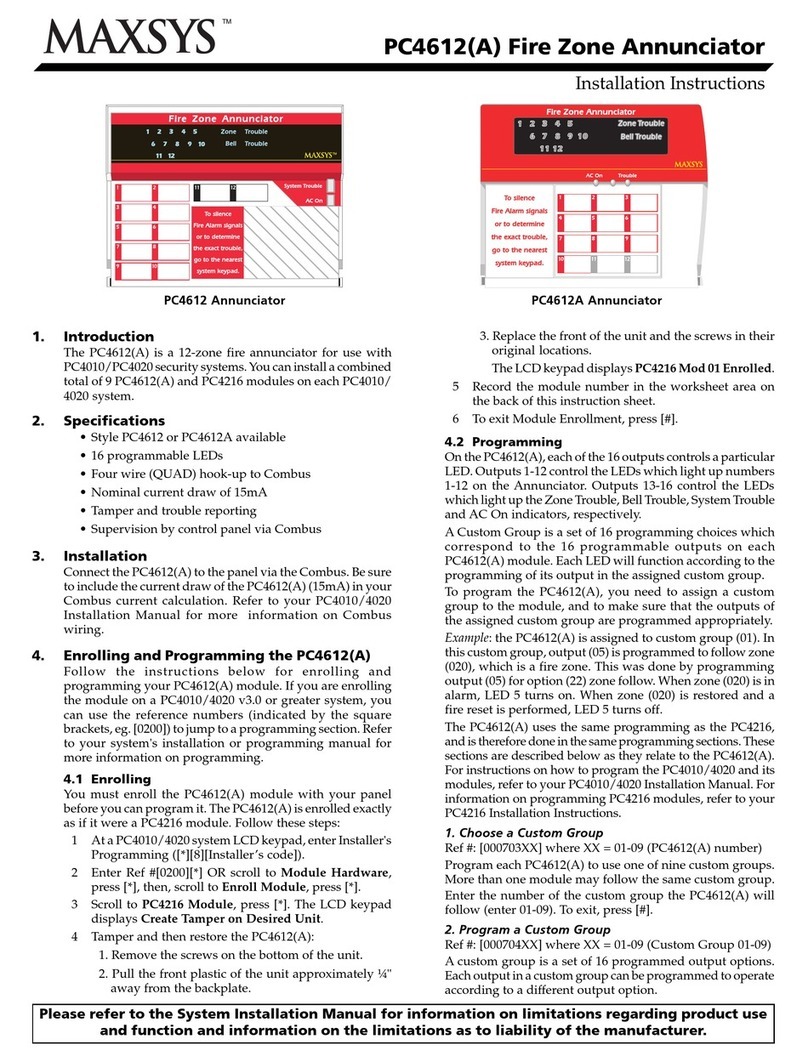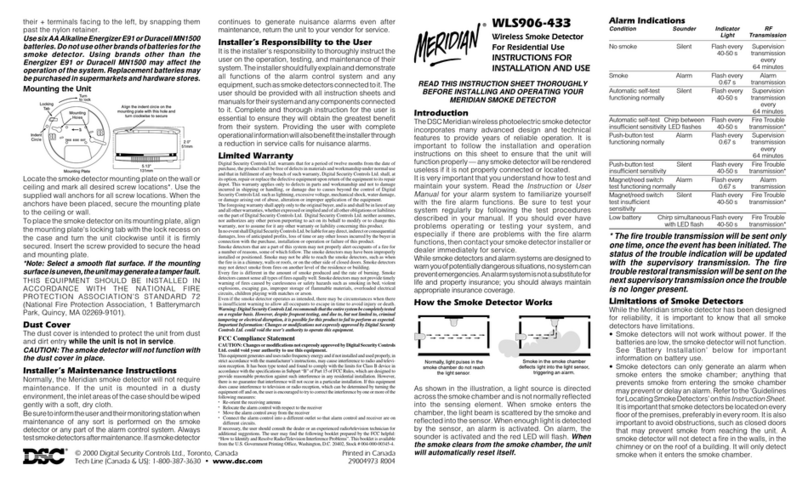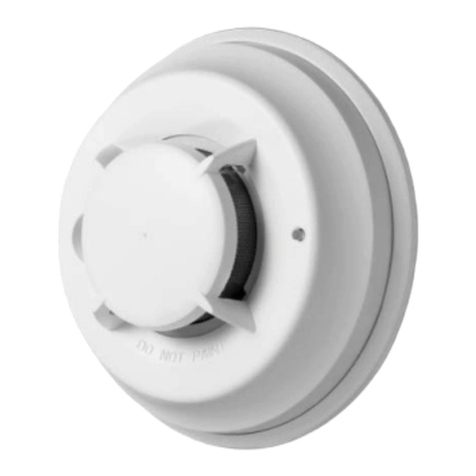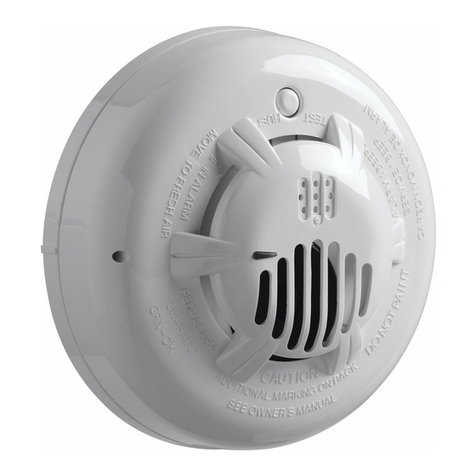
Mounting the Unit
Locate the smoke detector mounting plate on the wall or ceiling
and mark all desired screw locations. Use the supplied wall
anchors for all screw locations. When the anchors have been
placed, secure the mounting plate to the ceiling or wall.
To place the smoke detector on its mounting plate, align the
mounting plate's locking tab with the lock recess on the case and
turn the unit clockwise until it is firmly secured.
THIS EQUIPMENT SHOULD BE INSTALLED IN ACCO DANCE
WITH THE NATIONAL FI E P OTECTION ASSOCIATION’S
STANDA D 72. (National Fire Protection Association, Batterymarch
Park, Quincy, MA 02269)
Dust Cover
The dust cover is intended to protect the unit from dust and dirt
entry, only while the unit is not in service.
CAUTION: The smoke detector will not function with the dust
cover in place.
Installer’s Maintenance Instructions
Normally, the Meridian smoke detector will not require maintenance.
If the unit is mounted in a dusty environment, the inlet areas of the
case should be wiped gently with a soft, dry cloth.
Be sure to inform the user and their monitoring station when
maintenance of any sort is performed on the smoke detector or any
part of the alarm control system. Always test smoke detectors after
maintenance. If a smoke detector continues to generate nuisance
alarms even after maintenance, return the unit to DSC for service.
Contact DSC at the address and number below to obtain a return
authorisation number before returning the unit.
Installer’s Responsibility to the User
It is the installer’s responsibility to thoroughly instruct the end user
of the system on the operation, testing and maintenance of their
system. The installer should fully explain and demonstrate all
functions of the alarm control system and any equipment, such as
smoke detectors, connected to it. The user should be provided with
all instruction sheets and manuals for their system and any
components connected to it. Complete and thorough instruction
for the user is essential to ensure they will obtain the greatest
benefit from their system. Providing the user with complete
operational information will also benefit the installer through a
reduction in service calls for nuisance alarms.
Limited Warranty
Digital Security Controls Ltd. warrants that for a period of twelve months from the
date of purchase, the product shall be free of defects in materials and workmanship
under normal use and that in fulfilment of any breach of such warranty, Digital
Security Controls Ltd. shall, at its option, repair or replace the defective equipment
uponreturn oftheequipmenttoits repairdepot. Thiswarranty appliesonlytodefects
in parts and workmanship and not to damage incurred in shipping or handling, or
damage due to causes beyond the control of Digital Security Controls Ltd. such as
lightning, excessive voltage, mechanical shock, water damage, or damage arising
out of abuse, alteration or improper application of the equipment.
The foregoing warranty shall apply only to the original buyer, and is and shall be in
lieu of any and all other warranties, whether expressed or implied and of all other
obligationsorliabilitiesonthe partofDigitalSecurityControls Ltd. DigitalSecurity
Controls Ltd. neither assumes, nor authorizes any other person purporting to act on
itsbehalftomodifyortochangethiswarranty,nortoassumeforitanyotherwarranty
or liability concerning this product.
In no event shall Digital Security Controls Ltd. be liable for any direct, indirect or
consequential damages, loss of anticipated profits, loss of time or any other losses
incurred by the buyer in connection with the purchase, installation or operation or
failure of this product.
Smoke detectors that are a part of this system may not properly alert occupants of a
fire for a number of reasons, some of which follow. The smoke detectors may have
been improperly installed or positioned. Smoke may not be able to reach the smoke
detectors, such as when the fire is in a chimney, walls or roofs, or on the other side of
closed doors. Smoke detectors may not detect smoke from fires on another level of
the residence or building.
Every fire is different in the amount of smoke produced and the rate of burning.
Smoke detectors cannot sense all types of fires equally well. Smoke detectors may
not provide timely warning of fires caused by carelessness or safety hazards such as
smoking in bed, violent explosions, escaping gas, improper storage of flammable
materials, overloaded electrical circuits, children playing with matches or arson.
Even if the smoke detector operates as intended, there may be circumstances
when there is insufficient warning to allow all occupants to escape in time to
avoid injury or death.
Warning: Digital Security Controls Ltd. recommends that the entire system be
completelytested onaregular basis.However,despitefrequenttesting, anddueto, but
not limited to, criminal tampering or electrical disruption, it is possible for this
product to fail to perform as expected.
Important Information: Changes or modifications not expressly approved by Digital
Security Controls Ltd. could void the user’s authority to operate this equipment.
FCCCompliance Statement
CAUTION:Changesormodifications not expresslyapprovedbyDigitalSecurity
Controls Ltd. could void your authority to use this equipment.
This equipment generates and uses radio frequency energy and if not installed and used
properly, in strict accordance with the manufacturer’s instructions, may cause interfer-
ence to radio and television reception. It has been type tested and found to comply with
the limits for Class B device in accordance with the specifications in Subpart “B” of Part
15 of FCC Rules, which are designed to provide reasonable protection against such inter-
ference in any residential installation. However, there is no guarantee that interference
will not occur in a particular installation. If this equipment does cause interference to
television or radio reception, which can be determined by turning the equipment off and
on, the user is encouraged to try to correct the interference by one or more of the following
measures:
•Re-orient the receiving antenna
•Relocate the alarm control with respect to the receiver
•Move the alarm control away from the receiver
•Connect the alarm control into a different outlet so that alarm control and receiver are
on different circuits.
If necessary, the user should consult the dealer or an experienced radio/television techni-
cian for additional suggestions. The user may find the following booklet prepared by the
FCC helpful: “How to Identify and Resolve Radio/Television Interference Problems”.
This booklet is available from the U.S. Government Printing Office, Washington, D.C.
20402, Stock # 004-000-00345-4.
For more information and technical assistance:
© 2000 Digital Security Controls Ltd.
Toronto, Canada
www.dscgrp.com
29004973 001
